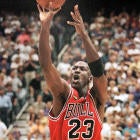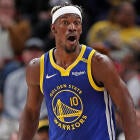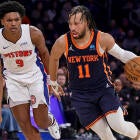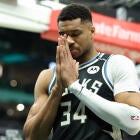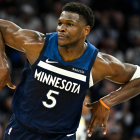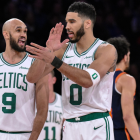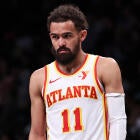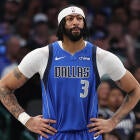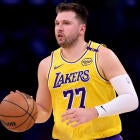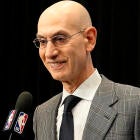Stop me if you've heard this one before. The Chicago Bulls are down by one. Only seconds remain on the game clock. The ball makes its way into the hands of Michael Jordan. And, surprise, the ball drops through the hoop to give his team the win. That description applies to dozens of Jordan's greatest moments, but most famously, it applies to his last one.
It's Game 6 of the 1998 NBA Finals. The Bulls trail the Utah Jazz by one point on the road. Jordan has just stolen the ball from Karl Malone and is eyeing Bryon Russell. With 10 seconds left on the clock, he attacks, ultimately freeing himself of Russell and putting the Bulls up by one with one of the greatest daggers in NBA history. A John Stockton miss cements not only the championship for Chicago, but the moment in our minds. Think of that game, that series and the rivalry as a whole and the first thing that comes to mind is Jordan hanging in the air over a defeated Russell, not the several shots that ultimately made it possible.
But Jordan's final shot was, fittingly, a culmination, the result of two years worth of battles between the Bulls and Jazz. Were it not for the muscle memory and strategic adjustments built up over the two previous NBA Finals, Jordan's legendary moment would never have been possible. So let's dive into what might be the greatest shot in the history of basketball, starting with the play itself.
The first thing you notice upon rewatching the play? How clean it is. There is none of the chaos that typically permeates end-of-game situations. The court is spaced nicely. Everyone is exactly where they need to be. Jordan doesn't wait until the last second to fire away. The shot goes through the basket with around five seconds on the clock. For a play that wasn't drawn up during a timeout, the whole thing looks remarkably scripted.
That is no accident. The Bulls had exhausted their entire supply of late-game tactics by this point through nine previous Finals games against the Jazz that ended with a single-digit margin. There are no secrets left between these teams, and through vicious trial-and-error, the Bulls have learned what works. After all, this is not even the first buzzer-beater scenario they've faced in this series. In fact, in both of Utah's wins to this point, the Bulls have had a chance to either tie or win the game with a shot at the buzzer. Both situations embody the chaos that was lacking in Game 6.
At the end of Game 1, the Bulls got the ball back after a John Stockton free throw with only a few seconds remaining. With no timeout, they needed to throw a full-court pass to give Jordan any hope of tying the game. When he lost control, Scottie Pippen was forced to throw up a low-percentage 3-pointer.
It missed, and Utah won the game. The end of Game 5 was even wilder. The Bulls, trailing by two, needed to inbound the ball with only 1.1 seconds left. John Stockton knocked the inbounds pass out of bounds.
That initially knocked 0.8 seconds off of the clock. With only 0.3 seconds left, the Bulls would only legally be able to score through a tip-in or a foul. Phil Jackson argued his way back up to 0.8 seconds on the clock, but all the Bulls could muster was a wild 3-pointer from Jordan.
Chicago had no interest in repeating these experiences. Its best chance at a clean shot would come earlier in the clock. So Jordan fired with several seconds left on the clock, and after it went in, it was the Jazz that had to scramble for an ugly late-game look. It wasn't the mathematically correct decision, but if anyone has earned the benefit of the doubt in such situations, it's Jordan.
So we've established the "when" of the shot, but what about the "where?" Jordan does something peculiar after stealing the ball from Karl Malone. The fastest route between any two points is a straight line, yet Jordan doesn't beeline for the basket. He crosses the court, going from the left block on his own end of the court to the left wing on Utah's.
To explain this, we need to rewind around 30 seconds. The jumper over Russell wasn't Jordan's only big shot in this game. With 41 seconds left, John Stockton hit a 3-pointer to give the Jazz an 86-83 lead. In response, Jordan quickly takes an inbounds pass from Pippen all the way to the hoop. He goes right, beating Russell, but meeting Antoine Carr at the rim, forcing him into a tricky finish.
Jordan knows that Utah will be expecting him to drive right again. Their defense is even set up for it. Let's take another look at Jordan's shot. This time, watch Karl Malone specifically.
Malone is nominally guarding Pippen, but look how far off he's willing to sag. Pippen, at this point, is hardly a threat. He dealt with a back injury throughout the NBA Finals that he aggravated on Game 6's first play, a dunk. So while Malone is technically guarding him, he is really expected to serve as the last line of defense against Jordan. That much is obvious watching his reaction to Jordan's drive. He shuffles into rim-protection mode expecting Jordan to attack the basket by driving right, as he had on the previous play. Russell, to an extent, does too. While Jordan may or may not have pushed him, his momentum was certainly already headed in that direction.
But that raises another question. While there was help behind him, Russell was defending Jordan one-on-one. That left him vulnerable to the exact sort of move Jordan pulled off. If he could shake Russell, he would have a clean look no matter what. So why didn't Utah double-team Jordan on the ball, or at least provide Russell more robust protection than a rotating Malone?
Because the Jazz already tried that, and it failed.
A year earlier, at literally the exact same point in the season, the Bulls found themselves in an eerily similar situation. Jordan had the ball with the score tied at 86 and only around 10 seconds remaining in Game 6 of the 1997 NBA Finals. Russell was guarding him at that point as well, but Utah didn't consider him enough, so it decided to double Jordan with John Stockton. Stockton's original man was Steve Kerr. A driving Jordan, from the same left wing at which he initiated his 1998 shot, passed out of the double team to Kerr just behind the free-throw line. He nailed the shot to win the championship.
That took a double-team off of the table in 1998. The Jazz weren't going to risk Jordan passing into yet another wide-open series-clincher. So they trusted Russell to contain Jordan himself, hoping that even if he failed, Jordan would attack the basket and meet additional rim-protection there.
That, obviously, is not what happened. Jordan's experiences through nearly 12 full Finals games against Utah compelled him to seek out a specific shot against a specific defense under specific circumstances. He found that shot, and the rest is history, but it goes to show that no play exists in isolation. This one was the culmination of two series' worth of lessons, a final exam covering everything Jordan had learned in two full series against the Jazz. Just as he did with nearly every basketball test he faced in his career, Jordan aced it.
![[object Object] Logo](https://sportshub.cbsistatic.com/i/2020/04/22/e9ceb731-8b3f-4c60-98fe-090ab66a2997/screen-shot-2020-04-22-at-11-04-56-am.png)








